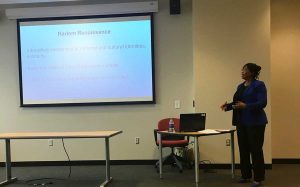
Critical conversation explores movement and migration of African-Americans
Black History Month (BHM) calls for events of celebration and learning for students of all backgrounds on the UHCL campus. Each year there is a theme and this year was is Black Migrations, which explores the movement and migration of Black people to the United States, within the U.S., and from the U.S. to other countries.
As part of this year’s celebrations the Office of Student Diversity, Equity and Inclusion, in collaboration with the Black Student Association (BSA), held an event titled “Critical Conversation – The African Diaspora Migration: Negritude, Negrismo, and the Harlem Renaissance Movements” Feb. 27. Aliya Beavers, director of student diversity, equity and inclusion, described the migrations of Black people as coming and going with “shifts in social realities and worldviews” as these migrations “gave rise to a lot of Black cultural themes we see today.”

“Often, we are interacting with issues of diversity, equity and inclusion on a shallow level, but being in a space and focusing in on a particular topic gives folks an opportunity to ask questions, engage with others, and unpack the different nuances of a particular subject area,” Beavers said. “This event provided a platform of discussion to UHCL students of all backgrounds to expand their knowledge and take in various perspectives.”
More than six million African-Americans living in the U.S. participated in the Great Migration, from about 1916 to 1970, as they relocated from the rural South to the cities of the West, Midwest, and North. The percentages of the Black population grew by large numbers in major cities such as New York with a 66 percent increase, Chicago with a 148 percent increase, and Philadelphia with a 500 percent increase.
This increase led to housing tensions where black people began to create their own cities within large cities, as they did with Harlem, New York, which had been an all-white neighborhood. This paved the way for a new African-American culture to emerge, and what was first known as the New Negro Movement, now known as the Harlem Renaissance, was born. By 1970, the Great Migration ended leaving no more than 25 percent of the black population in the South.
The presentation was given by Carole Sylvers, professor of African-American Studies at the University of Houston. While discussing why it is important to celebrate Black History Month in the U.S., Sylvers pointed out, “Every country has an Emancipation Day except for the United States. Central America, South America, the Caribbean Islands, even Canada, but not the U.S.”
“You don’t have a Black history in the high schools here where in other states you can take Chinese history or Mexican history; here, you take Texas History,” Sylvers said. “By learning the background and the history of different ethnic groups, we understand the contemporary, so we have to go back in time to get a foundation to understand what’s going on now, and that’s lost.”
The presentation covered Black history as well as Afro-Latino history and covered such topics as The Great Migration, Negritude, Negrismo, Rastafari and how modern-day cultures came to be what they are today.
“To minimize that slavery took place means it didn’t occur,” Sylvers said. “We need to know where it started; it didn’t start in the U.S.”
Each February holds a different theme for what BHM will showcase, all members of UHCL are welcome to participate.
“Participants leave discussions such as these with a new-found understanding of an issue, and they are able to think about issues from a different perspective,” Beavers said.
